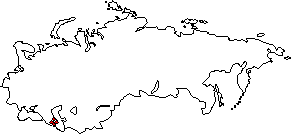CONTENTS
IntroductionForeword
Language Groups
Tribes and Dialects
Order the book
The Peoples
of the Red Book
Abazians (Abaza)Abkhaz
Aguls
Akhvakhs
Aleuts
Altaics
Aliutors
Andis
Archis
Asiatic Eskimos
Bagulals
Baraba Tatars
Bartangs
Bats
Bezhtas
Botlikhs
Budukhs
Central Asian Jews
Chamalals
Chukchis
Chulym Tatars
Crimean Jews
Crimean Tatars
Didos
Dolgans
Enets
Evens
Evenks
Georgian Jews
Godoberis
Hinukhs
Hunzibs
Ingrians
Ishkashmis
Itelmens
Izhorians
Kamas
Karaims
Karatas
Karelians
Kereks
Kets
Khakass
Khants
Khinalugs
Khufis
Khvarshis
Kola Lapps
Koryaks
Kryz
Kurds
Lithuanian Tatars
Livonians
Mansis
Mountain Jews
Nanais
Negidals
Nenets
Nganasans
Nivkhs
Nogays
Orochis
Oroks
Oroshoris
Peoples of the Pamirs
Roshanis
Rutuls
Selkups
Shors
Shughnis
Tabasarans
Talysh
Tats (Tatians)
Tindis
Tofalars
Trukhmens (Turkhmens)
Tsakhurs
Udeghes
Udis
Ulchis
Veps
Votes
Wakhs
Yaghnabis
Yazgulamis
Yukaghirs

THE MOUNTAIN JEWS
Habitat. The majority of Caucasian Mountain Jews live in Dagestan, Kaitag and Magaramkend (three settlements), and in Derbent and Makhachkala, they can be found in a few Azerbaijani villages (Krasnaya Sloboda, Vartashen) and in some towns. A small number have settled in North Caucasia -- Gorny and Nalchik.
Population. The population is difficult to estimate, as during the censuses the Mountain Jews have been counted as members of the overall Jewish community, or as Tats whose language they speak. In 1926 they numbered approximately 26,000; in 1959 about 15,000 lived in Dagestan (the Russian Federation total was 16,707) and more than 10,000 in Azerbaijan. In 1979 the overall number of Jews in Dagestan was 19,000 and 35,000 in Azerbaijan, the percentage of Mountain Jews is unknown.
Language. The Mountain Jews belong to the Iranian division of the Indo-European languages. They speak Tat, a dialect of New-Persian. The same language is spoken by the Tats of Azerbaijan and Dagestan to whom the Mountain Jews have sometimes been considered to belong.
In terms of ethnic origin, it is assumed that the Mountain Jews and Tats have inhabited Caucasia for a long time. Their distant forefathers once lived in southern Azerbaijan, the north-western part of present-day Iran. It was there that they adopted the Tat language but retained Judaism as their faith (the Tats are Islamic). Having become largely assimilated, the predecessors of the Mountain Jews settled on the west coast of the Caspian Sea in the 5th--6th century and from that time on their history has been related to the mountains and the people of Dagestan. They resettled from the mountains to the coastal lowlands in the 18th--19th century but carried the name Mountain Jews with them.
Any specific Mountain Jew features, distinguishing them from the Islamic environment, originate in Judaism. In the villages (aouls) the Mountain Jews settled in a part of their own, in towns they did the same, although their dwellings did not differ from their neighbours'. The Mountain Jews also took to wearing the highlanders' dress. Judaistic prohibitions ensured they retained specific dishes and faith still enshrined in the rules for family life.
If elsewhere in the Jewish diaspora it was forbidden to own and till land (cf. the Jews of Central Asia), at the end of the 19th and the beginning of the 20th century the Mountain Jews were farmers and gardeners growing mainly grain. Their oldest occupation was rice-growing but raising silkworms and tobacco was also popular. The Jewish vineyards were especially famous. The Jews and their Armenian neighbours were the main producers of wine, an activity banned for Muslims by religion. Judaism, in turn, strictly limited any meat consumption and unlike their neighbours the Mountain Jews raised few domestic animals.
At the same time they were renowned tanners. Tanning was the third most important activity after farming and gardening and at the end of the 19th century 6 % of Jews were engaged in this trade. Handicrafts and commerce were mostly practiced by Jews in towns.
The Soviet authorities bound the Mountain Jews to collective farms but allowed them to carry on in their traditional ways (they grew grapes, tobacco and vegetables and made wine). However, the former isolated lifestyle of the Jews has practically been eradicated and they now live side by side with other ethnic groups.
Originally education was only for the boys who attended synagogue schools. With sovietization Tat became the language of tuition at newly-founded elementary schools. It remained so till the beginning of World War II. The publication of the first native-language newspaper, Zakhmetkesh (Working People), began in 1928. After the war Russian became the only acceptable language at Dagestan schools and the publication of the newspaper stopped. Today Mountain Jewish intellectuals are active in the Dagestan cultural scene. Several of them are prominent actors and artists and there are writers and poets. However, only amateur theatricals and concerts are there to highlight their ethnic culture. All Mountain Jewish activities in Azerbaijan are supressed by flourishing Azerbaijani chauvinism.
REFERENCES
- К. М. Курдов, Горские евреи Дагестана. -- Русский антропологический журнал 3/4, 1905
- З. А. Никольская, Е. М. Шиллинг, Горские евреи. -- Народы Кавказа. Т. 1, Москва 1960
IT